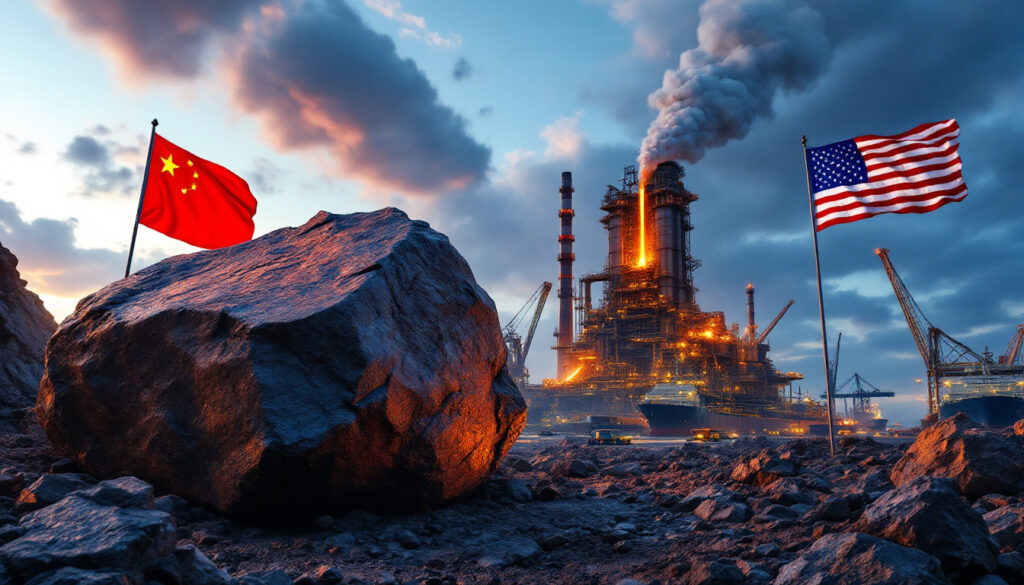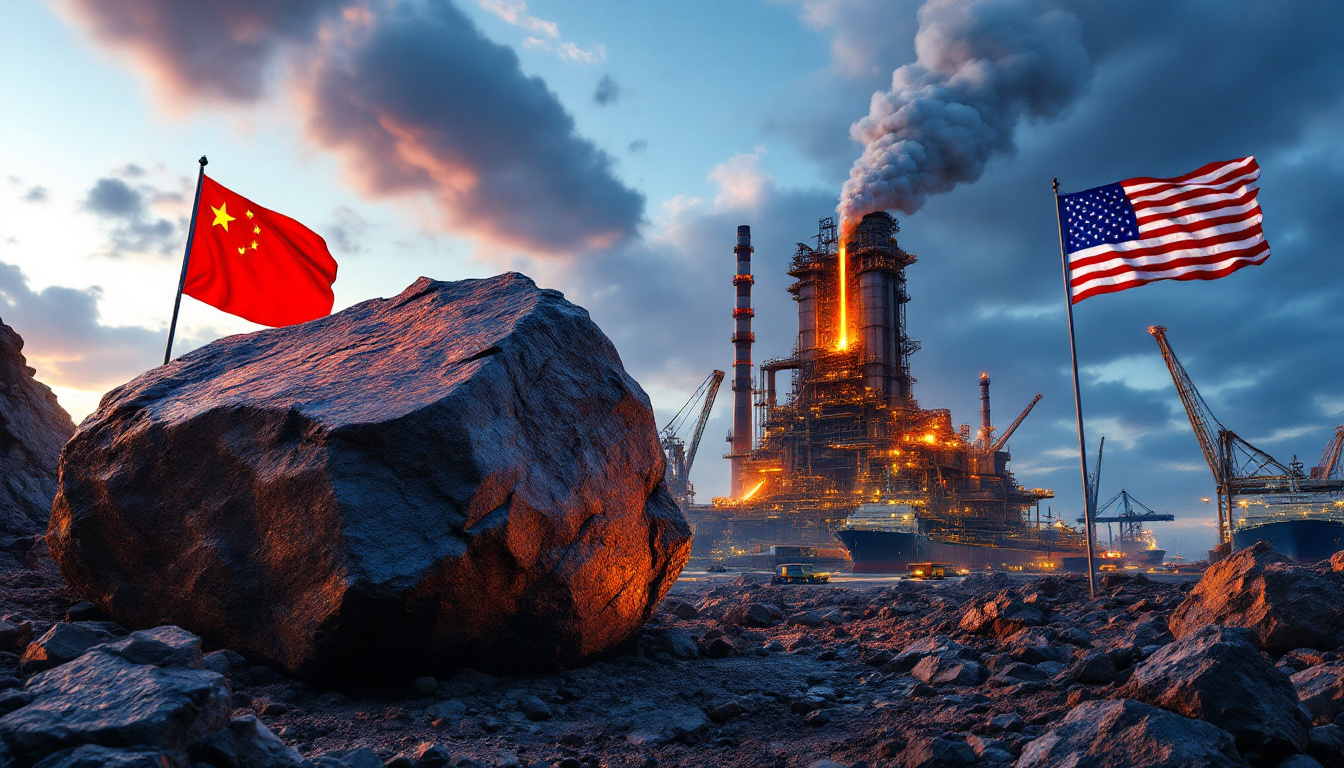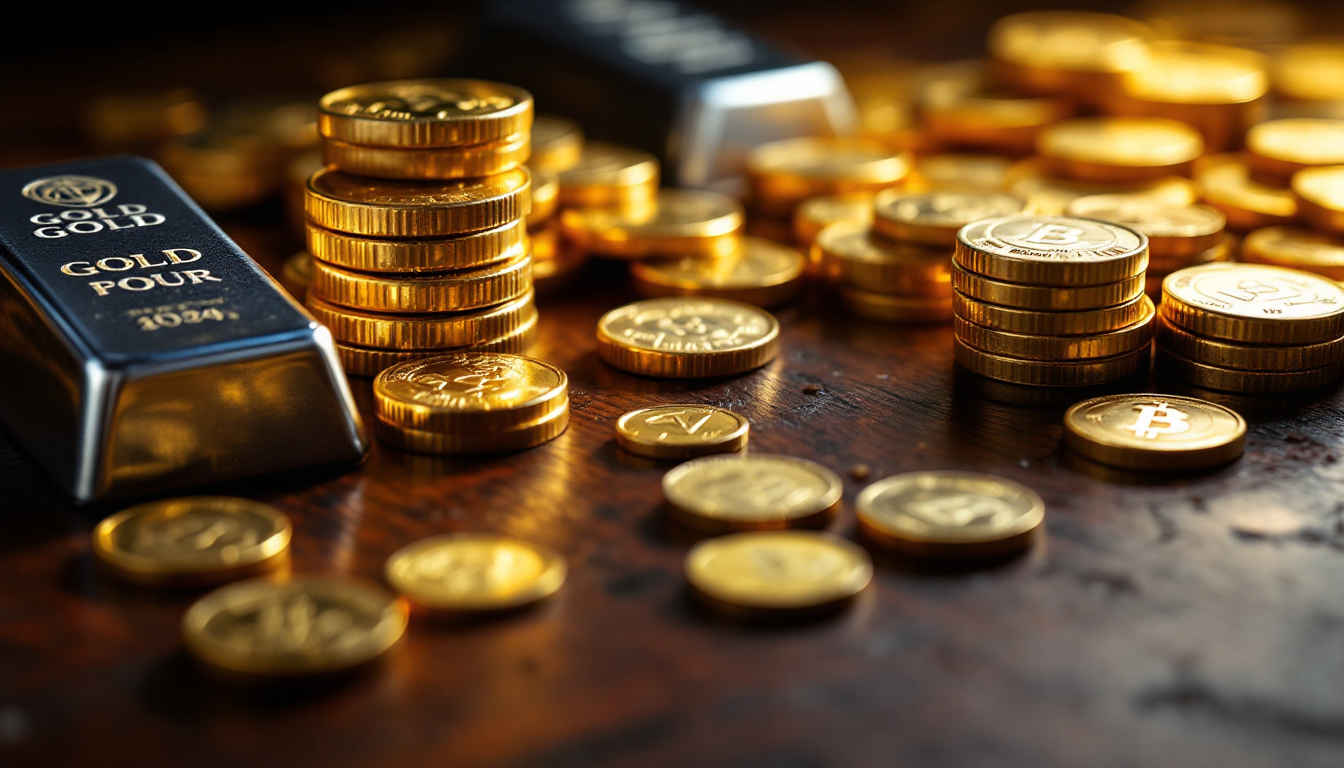Iron Ore Back in Vogue as Prices Surge Above $100/t
Iron ore has surged back above US$100/t, driving major mining stocks to their highest levels since early April 2025. This resurgence comes amid improving US-China trade relations and surprisingly robust Chinese steel production despite broader economic challenges in the world's largest steel producer.
Market analysts note that iron ore's resilience stands in contrast to other commodities like lithium, which continues to languish at multi-year lows. The ferrous metal's comeback reflects both supply constraints and unexpected demand strength, creating a market dynamic that has caught many observers by surprise.
What's Driving the Iron Ore Price Recovery?
US-China Trade Tensions Easing
The 90-day pause in trade hostilities between the world's two largest economies has significantly improved market sentiment. Reciprocal tariffs have been reduced from extreme levels (145% and a retaliatory 125%) to more moderate rates of 30% and 10% respectively, creating breathing room for commodities markets.
Major miners have benefited substantially from this improved outlook:
- Rio Tinto shares have climbed 14.3% since the trade truce announcement
- BHP has gained 11.7% over the same period
- Fortescue Metals Group has surged 16.2%, reaching its highest valuation since April 2, 2025
This recovery marks a dramatic turnaround from the market turbulence following what analysts had dubbed Trump's "Liberation Day" trade war escalation in March 2025, when tariffs were suddenly increased to punitive levels.
Surprising Chinese Steel Demand Resilience
Despite persistent concerns about China's economic trajectory, steel production has shown remarkable resilience:
- Chinese steel production increased 1.1% year-over-year in Q1 2025
- Daily steel output reached 2.8 million tonnes in early May 2025, compared to 2.6 million tonnes in early January
- Steel inventories sit at just 11.6 million tonnes – the lowest level for this time of year since 2016
- The steel industry's Purchasing Managers Index in China remained in expansionary territory at 50.3 in April
"The steel sector is demonstrating impressive resilience despite property sector headwinds," notes Daniel Morgan, commodities analyst at UBS. "This resilience is primarily driven by infrastructure spending and manufacturing growth, which are offsetting weakness in construction."
Supply Constraints Supporting Prices
Several supply-side factors have contributed to iron ore's price stability:
- Severe cyclones disrupted Pilbara exports earlier in 2025, reducing Australian shipments by approximately 15 million tonnes
- Rio Tinto is facing quality issues with its flagship product, with Pilbara Blend fines being downgraded from 61.6% Fe to 60.8% Fe from July to September 2025
- This quality reduction requires steelmakers to purchase more material and blend with higher-grade products, creating additional demand
The combination of these supply constraints with better-than-expected demand has created a price floor that has repeatedly held at around $95/tonne throughout early 2025.
How Are Analysts Viewing the Iron Ore Market?
Bullish Perspective: ANZ Research
ANZ Research has recently adopted a more optimistic outlook for iron ore:
- Short-term price target raised to US$100/t from previous US$90/t
- Forecasts Chinese steel demand to grow for first time since 2020, reaching 998 million tonnes
- Notes that non-property steel demand now represents 72% of total Chinese consumption, up from 65% in 2021
- Fixed asset investment growth increased to 4.2% in March from 3.2% in December 2024
- Heavy industry sector investment (railways, shipbuilding) up 20% year-over-year in Q1 2025
"The diversification of Chinese steel demand away from property dependency is a structural shift that many market participants have underestimated," says Daniel Hynes, Senior Commodity Strategist at ANZ. "Infrastructure and manufacturing sectors are now the primary growth drivers for Chinese steel consumption."
Bearish Perspective: Westpac
Not all analysts share this optimism. Westpac maintains a more cautious outlook:
- Predicts prices falling below US$90/t in second half of 2025
- Cites Chinese steel companies forecasting "strong supply and weak demand" conditions
- Points to Simandou project in Guinea beginning production earlier than expected (November rather than December)
- Believes current price stability unlikely to hold through year-end due to increasing supply surplus concerns
"The iron ore market is currently balanced on a knife edge," warns Robert Rennie, Head of Financial Market Strategy at Westpac. "Any significant increase in supply or decrease in demand could quickly tip prices back into a downward trajectory."
What Impact Will the Simandou Project Have?
Potential Market Disruption
The massive Guinea-based Simandou iron ore project represents one of the most significant potential supply additions in decades:
- First shipments from Simandou confirmed to reach port of Moribaya in November 2025
- Phase 1 production expected to be 60 million tonnes per annum (mtpa)
- Full production capacity of 120mtpa once fully operational by 2027
- Ore quality estimated at 65.5% Fe content, significantly higher than Australian average of 61-62%
"Simandou represents the single largest threat to iron ore price stability in the medium term," explains Paul McTaggart, mining analyst at Citi. "The combination of its scale and high-grade quality could fundamentally alter global iron ore market types & deposits, particularly for premium products."
Environmental and Infrastructure Considerations
The Simandou project faces several challenges that could impact its development timeline:
- Complex 670km railway construction through challenging terrain
- Environmental concerns regarding biodiversity in the Simandou mountain range
- Community relations issues requiring careful management
- Political stability questions in Guinea following recent government changes
These factors have led some analysts to remain skeptical about whether the project will meet its announced timeline, potentially providing temporary relief to iron ore price trends.
How Are ASX Mining Stocks Performing?
Top Performers (Past Week)
The ASX 300 Metals and Mining index has risen 2.14% over the past week, with several standout performers:
- Liontown Resources (LTR): +51.9% despite lithium price slump, driven by speculation around Gina Rinehart's stake building
- Mineral Resources (MIN): +28%, benefiting from diversified exposure to both lithium and iron ore
- Alcoa Corporation (AAI): +15%, riding the aluminum sector's broader gains
- WA1 Resources (WA1): +9.2%, following promising niobium exploration results
This performance highlights the market's growing preference for companies with diversified commodity exposure or specific catalyst-driven stories.
Underperformers (Past Week)
The easing of US-China trade tensions has reduced safe-haven demand for gold, impacting gold-focused miners:
- Ora Banda (OBM): -15.6%
- Ramelius Resources (RMS): -13.4%
- Vault Minerals (VAU): -12.9%
- Capricorn Metals (CMM): -12.7%
"The rotation out of gold stocks and into base metals and surging iron ore miners demonstrates a clear shift in risk appetite among resources investors," observes Peter O'Connor, metals and mining analyst at Shaw and Partners.
What's Happening in China's Property Market?
Shifting Steel Demand Patterns
The Chinese property sector continues to face significant challenges, but other sectors are increasingly compensating for this weakness:
- Property sector steel demand declined 8.3% year-over-year in Q1 2025
- Non-property steel demand now comprises 72% of total Chinese consumption
- Infrastructure steel demand increased 4.7% in Q1 2025
- Manufacturing sector steel consumption rose 3.2% in the same period
- Chinese government implementing 3.9 trillion yuan in economic support measures to offset property weakness
This structural shift represents a significant evolution in Chinese steel consumption patterns that many international observers have been slow to recognize.
Infrastructure Investment Surge
China's pivot toward infrastructure spending is creating substantial steel demand:
- Railway investment up 24.7% year-over-year in Q1 2025
- Water conservation projects investment increased 19.3%
- Energy infrastructure spending rose 15.8%
- Urban transit projects growing at 17.2%
"The scale of China's infrastructure push is difficult to overstate," notes Robin Griffin, Director of Steel and Raw Materials Research at Wood Mackenzie. "While property sector weakness garners headlines, the infrastructure buildout is quietly absorbing enormous quantities of steel."
Is the Iron Ore Rally Sustainable?
Key Market Indicators to Watch
Several critical factors will determine iron ore's price trajectory through the remainder of 2025:
- Price has tested US$95/t support level four times in past six months without breaking down
- Current price: US$100.70/t as of mid-May 2025
- Steel mill margins remain negative despite production increases (-1.2% on average)
- Simandou production timeline will be critical for H2 2025 price direction
- Chinese government stimulus measures and infrastructure spending plans
- Evolution of US-China trade relations beyond the current 90-day ceasefire
"Iron ore's support levels have demonstrated remarkable resilience, suggesting a structural floor may exist around the $95/t mark," explains Vivek Dhar, mining and energy commodities analyst at Commonwealth Bank. "However, Simandou's entry to the market could test this floor significantly."
Comparative Commodity Performance
Iron ore's resilience stands in stark contrast to other commodities:
- Iron ore prices up 15.3% year-to-date
- Lithium carbonate prices down 73.4% over the same period, at four-year lows
- Gold prices down 1.2% to AU$5,050/oz as trade tensions ease
- Copper showing strength, up 8.7% year-to-date on energy transition demand
Diversified miners with exposure to multiple commodities (like MIN) are outperforming single-commodity producers, reflecting market preference for reduced concentration risk, according to a recent analysis by Morningstar.
Geological and Quality Considerations
The iron ore market is increasingly stratified by quality considerations:
- Premium high-grade ore (65% Fe) commands a $23/t premium over 62% Fe benchmark
- Discount for lower-grade ore (58% Fe) has widened to $19/t from $12/t a year ago
- Chinese environmental regulations driving preference for higher-grade material
- Rio Tinto's quality issues with Pilbara Blend creating market disruption
These quality differentials are creating opportunities for producers of premium ore while challenging those with lower-grade deposits, as reported by Reuters.
FAQ: Iron Ore Market Outlook
Why is Chinese steel production increasing despite economic challenges?
Chinese steel production is rising due to strong demand from infrastructure, manufacturing, and heavy industry sectors, which now represent 72% of total demand. Fixed asset investment growth rose to 4.2% in March 2025, while heavy industry investment jumped 20% year-over-year in Q1. This sectoral shift represents a structural change in Chinese steel demand patterns.
How might the Simandou project affect iron ore prices?
The Simandou project in Guinea, scheduled to begin exports in November 2025, represents a significant new supply source that could pressure prices in late 2025 and beyond. With Phase 1 production of 60mtpa and a full capacity of 120mtpa, the project's high-grade ore (65.5% Fe) will increase global supply and potentially shift market dynamics, particularly for premium products.
What factors are supporting iron ore prices above US$100/t?
Current price support comes from a combination of reduced US-China trade tensions, resilient Chinese steel production, supply disruptions in the Pilbara, and quality issues with Rio Tinto's flagship product requiring more blending with higher-grade ores. The market has repeatedly tested but respected the $95/t support level over the past six months.
How are Chinese steel inventories affecting the market?
Steel inventories in China are currently at 11.6mt, the lowest level for this time of year since 2016. These low inventory levels support continued production despite negative steel mill margins, as producers work to replenish stocks in anticipation of potential demand increases from government stimulus measures.
Investment Implications
For investors considering exposure to the iron ore sector, several strategies merit consideration:
- Focus on producers with lower cost bases like Fortescue Metals Group, which can remain profitable even if prices decline
- Consider companies with exposure to higher-grade ore that commands premium pricing
- Evaluate miners with diversified commodity exposure to mitigate single-commodity risk
- Monitor Chinese policy announcements for clues about infrastructure spending plans
- Watch Simandou development timelines closely for potential market impacts
"The iron ore market remains one of the most politically sensitive commodity sectors globally," cautions John Tivey, Global Head of Mining & Metals at White & Case. "Investors need to consider not just supply-demand fundamentals but also the geopolitical dimensions that increasingly influence pricing."
As iron ore comes back in vogue with investors, the interplay between Chinese demand patterns, global trade relations, and new supply additions will continue to shape market dynamics through 2025 and beyond. Many analysts are now reviewing their ore forecast insights as market conditions evolve.
Want to Catch the Next Major Mining Discovery Before the Market Does?
Discover why major mineral discoveries can lead to extraordinary market returns with Discovery Alert's proprietary Discovery IQ model that instantly identifies significant ASX mineral announcements. Visit the Discovery Alert discoveries page to explore historic examples of exceptional outcomes and begin your 30-day free trial today.




